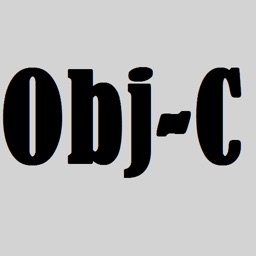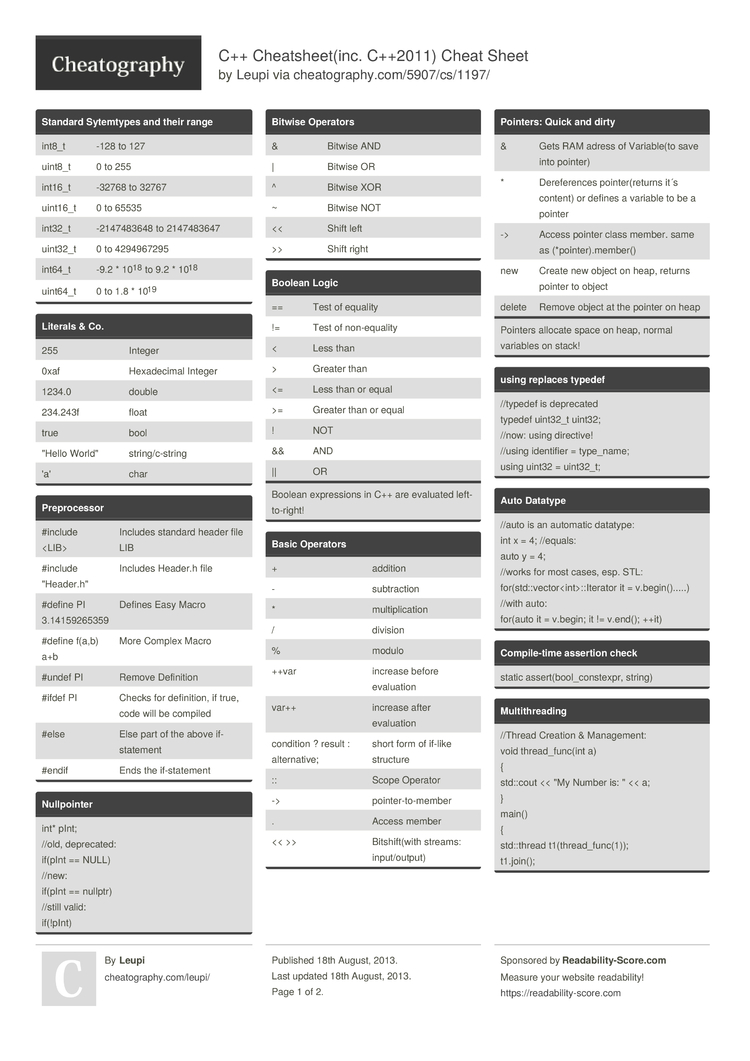- Objective-C Enjoy this cheat sheet at its fullest within Dash, the macOS documentation browser. Classes Class header (MyClassName.h) #import 'AnyHeaderFile.h' @interface MyClassName: SuperClassName // define public properties // define public methods @end. You can modify and improve this cheat sheet.
- OverAPI.com is a site collecting all the cheatsheets,all!
Well, your wish is our command – keep reading to download the official raywenderlich.com Objective-C cheatsheet!: Show Me The Cheat Sheet! Without further ado, here is the download link: Objective-C Cheatsheet and Quick Reference v1.5. It summarizes the most important Objective-C syntax on one page to get you up to speed quickly, including. Objective-C Cheat Sheet by alextgordon - Cheatography.com Created Date: 0225Z. A single platform to get more than 1000 + competitive objective questions, interview questions from various IT companies, tutorials, practice material, solved programs, projects, cheat sheets and Online Test (Certificate). All questions are compiled before uploading on this portal.


class
Declares class as known without having to import the class’ header file. | |
Marks end of the class, protocol or interface declaration. |

protocol

Marks the start of a protocol declaration. Get a protocol object by name: | |
Methods following are required (default). Mac OS 8 8.6 Apple Mac OS 8 was another major overhaul of the OS from the earlier Mac OS 7. It added a new Platinum visual theme, a multi threaded Finder, better virtual memory, and many customization options. 8.5 and later require a PPC CPU. It was followed up by Mac OS 9. 1999 Mac OS 8.6 (Veronica) Released on May 10, 1999, Mac OS 8.6 introduced the concept of a nanokernel to the Mac OS which allowed for multi-tasking and multi-processors. As such, it was the first version of the Mac OS to include the 'Mac OS ROM' file in the System Folder. Mac os 8.6 download. | |
Methods following are optional. Classes making use of the protocol must test Optional protocol methods for existence: |
interface
Marks the start of a class or category declaration. Objective-C classes should derive from NSObject directly or indirectly. Use @interface to declare that the class conforms to protocols. Category declaration - Objective-C category cannot add instance variables. Can to conform to (additional) protocols. CategoryName can be omitted if in implementation file making methods “private”. | |
Declares instance variables after @public directive as publicly accessible. Read and modified with pointer notation: | |
Declares instance variables after @package directive as public inside the framework that defined the class, but private outside the framework. Applies only to 64-bit systems, on 32- bit systems @package has the same meaning as @public. | |
Default. Declares instance variables after @protected directive as accessible only to the class and derived classes. | |
Declares the instance variables following the @private directive as private to the class. Not even derived classes can access private instance variables. | |
Declares a property which accessible with dot notation. @property can be followed by optional brackets within which property modifiers specify the exact behavior of the property. Property modifiers: readwrite (default), readonly – Generate both setter & getter methods (readwrite), or only the getter method (readonly). assign (default), retain, copy – For properties that can safely cast to id. Assign assigns passed value – retain sends release to an existing instance variable, sends retain to the new object, assigns the retained object to the instance variable – copy sends release to the existing instance variable, sends copy to the new object, assigns the copied object to the instance variable. In latter two cases you are responsible for sending release (or assigning nil) to the property on dealloc. atomic (default), nonatomic – Atomic properties are thread-safe. Nonatomic properties are not thread-safe. Nonatomic property access is faster than atomic and often used in single- threaded apps, or cases where you’re absolutely sure the property will only be accessed from one thread. strong (default), weak – Available if automatic reference counting (ARC) is enabled. The keyword strong is synonymous to retain, while weak is synonymous to assign, except a weak property is set to nil if instance is deallocated. | |
Guso seaweeds. Returns the selector type SEL of the given Objective-C method. Generates compiler warning if the method isn’t declared or doesn’t exist. |
implementation
Objective C Cheat Sheet Pdf
Marks start of a class’ or category implementation. Class implementation: Category implementation: | |
Generate setter and getter methods for a comma separated property list according to property modifiers. If instance variable is not named exactly like @property, you can specify instance variable name after the equals sign. | |
Tells the compiler the setter and getter methods for the given (comma separated) properties are implemented manually, or dynamically at runtime. Accessing a dynamic property will not generate a compiler warning, even if the getter/setter is not implemented. You will want to use @dynamic in cases where property getter and setter methods perform custom code. @end – Marks end of class implementation. | |
Encapsulates code in mutex lock ensuring that the block of code and locked object are only accessed by one thread at a time. | |
Declares a constant NSString object. Does not need to be retained or released. | |
Used for handling and throwing exceptions. Throwing and Handling exceptions: | |
Best time tracking software for 2017. In an ARC (automatic reference counting) enabled about 6x faster than NSAutoreleasePool and used as a replacement. Avoid using a variable created in an @autoreleasepool after the autoreleasepool block. | |
Returns the character string encoding of a type. | |
Sets alias name for an existing class. First parameter is the alias, second the actual class name. @compatibility_alias AliasClassName ExistingClassName After this you can use AliasClassName in place of ExistingClassName. |
Objective-c Cheat Sheet
Notes

Objective-c Block Cheat Sheet
- Based on a cheat sheet by Chaosky
